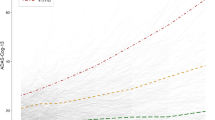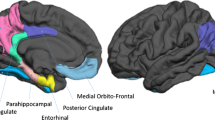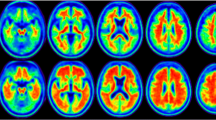Abstract
There is substantial biological heterogeneity among older adults with amnestic mild cognitive impairment (aMCI). We hypothesized that this heterogeneity can be detected solely based on volumetric MRI measures, which potentially have clinical implications and can improve our ability to predict clinical outcomes. We used latent class analysis (LCA) to identify subgroups among persons with aMCI (n = 696) enrolled in the Alzheimer’s Disease Neuroimaging Initiative (ADNI), based on baseline volumetric MRI measures. We used volumetric measures of 10 different brain regions. The subgroups were validated with respect to demographics, cognitive performance, and other AD biomarkers. The subgroups were compared with each other and with normal and Alzheimer’s disease (AD) groups with respect to baseline cognitive function and longitudinal rate of conversion. Four aMCI subgroups emerged with distinct MRI patterns: The first subgroup (n = 404), most similar to normal controls in volumetric characteristics and cognitive function, had the lowest incidence of AD. The second subgroup (n = 230) had the most similar MRI profile to early AD, along with poor performance in memory and executive function domains. The third subgroup (n = 36) had the highest global atrophy, very small hippocampus and worst overall cognitive performance. The fourth subgroup (n = 26) had the least amount of atrophy, however still had poor cognitive function specifically in in the executive function domain. Individuals with aMCI who were clinically categorized within one group other showed substantial heterogeneity based on MRI volumetric measures.



Similar content being viewed by others

References
Armitage, P., Berry, G., Matthews, J. N. S. (2008). Statistical methods in medical research. John Wiley & Sons.
Ball, K., Berch, D. B., Helmers, K. F., Jobe, J. B., Leveck, M. D., Marsiske, M., Morris, J. N., Rebok, G. W., Smith, D. M., Tennstedt, S. L., Unverzagt, F. W., Willis, S. L., & ACTIVE Study Group. (2002). Effects of cognitive training interventions with older adults: A randomized controlled trial. JAMA., 288, 2271–2281.
Beauchaine, T. P. (2003). Taxometrics and developmental psychopathology. Development and Psychopathology, 15, 501–527.
Bondi, M. W., Edmonds, E. C., Jak, A. J., Clark, L. R., Delano-Wood, L., McDonald, C. R., Nation, D. A., Libon, D. J., Au, R., Galasko, D., & Salmon, D. P. (2014). Neuropsychological criteria for mild cognitive impairment improves diagnostic precision, biomarker associations, and progression rates. Journal of Alzheimer's Disease, 42, 275–289.
Celeux, G., & Soromenho, G. (1996). An entropy criterion for assessing the number of clusters in a mixture model. Journal of Classification, 13, 195–212.
Crane, P. K., Carle, A., Gibbons, L. E., Insel, P., Mackin, R. S., Gross, A., et al. (2012). Development and assessment of a composite score for memory in the Alzheimer’s Disease Neuroimaging Initiative (ADNI). Brain Imaging and Behavior, 6, 502–516.
De Jong, L., Van der Hiele, K., Veer, I., Houwing, J., Westendorp, R., Bollen, E., et al. (2008). Strongly reduced volumes of putamen and thalamus in Alzheimer's disease: An MRI study. Brain., 131, 3277–3285.
DeCarli, C., Maillard, P., Fletcher, E. (2013). Four tissue segmentation in ADNI II. Alzheimer’s Disease Neuroimaging Initiative. Department of Neurology and Center for Neuroscience, University of California at Davis.
Devanand, D., Pradhaban, G., Liu, X., Khandji, A., De Santi, S., Segal, S., et al. (2007). Hippocampal and entorhinal atrophy in mild cognitive impairment prediction of Alzheimer disease. Neurology., 68, 828–836.
Dubois, B., & Albert, M. L. (2004). Amnestic MCI or prodromal Alzheimer's disease? The Lancet Neurology., 3, 246–248.
Edmonds, E. C., Delano-Wood, L., Clark, L. R., Jak, A. J., Nation, D. A., McDonald, C. R., Libon, D. J., Au, R., Galasko, D., Salmon, D. P., Bondi, M. W., & Alzheimer's Disease Neuroimaging Initiative. (2015). Susceptibility of the conventional criteria for mild cognitive impairment to false-positive diagnostic errors. Alzheimer’s & Dementia: The Journal of the Alzheimer’s Association, 11, 415–424.
Eppig, J. S., Edmonds, E. C., Campbell, L., Sanderson-Cimino, M., Delano-Wood, L., Bondi, M. W., & for the Alzheimer’s Disease Neuroimaging Initiative. (2017). Statistically derived subtypes and associations with cerebrospinal fluid and genetic biomarkers in mild cognitive impairment: A latent profile analysis. Journal of the International Neuropsychological Society, 23, 564–576.
Fischl, B., Salat, D. H., Busa, E., Albert, M., Dieterich, M., Haselgrove, C., van der Kouwe, A., Killiany, R., Kennedy, D., Klaveness, S., Montillo, A., Makris, N., Rosen, B., & Dale, A. M. (2002). Whole brain segmentation: Automated labeling of neuroanatomical structures in the human brain. Neuron., 33, 341–355.
Folstein, M. F., Folstein, S. E., & McHugh, P. R. (1975). “Mini-mental state”: A practical method for grading the cognitive state of patients for the clinician. Journal of Psychiatric Research, 12, 189–198.
Gibbons, L. E., Carle, A. C., Mackin, R. S., Harvey, D., Mukherjee, S., Insel, P., et al. (2012). A composite score for executive functioning, validated in Alzheimer’s Disease Neuroimaging Initiative (ADNI) participants with baseline mild cognitive impairment. Brain Imaging and Behavior, 6, 517–527.
Godyn, J., Jonczyk, J., Panek, D., & Malawska, B. (2016). Therapeutic strategies for Alzheimer's disease in clinical trials. Pharmacological Reports, 68, 127–138.
Grahn, J. A., Parkinson, J. A., & Owen, A. M. (2008). The cognitive functions of the caudate nucleus. Progress in Neurobiology, 86, 141–155.
Landau, S. M., Harvey, D., Madison, C. M., Koeppe, R. A., Reiman, E. M., Foster, N. L., Weiner, M. W., Jagust, W. J., & Alzheimer’s Disease Neuroimaging Initiative. (2011). Associations between cognitive, functional, and FDG-PET measures of decline in AD and MCI. Neurobiology of Aging, 32, 1207–1218.
Leoutsakos, J.-M. S., Forrester, S. N., Lyketsos, C., & Smith, G. S. (2015). Latent classes of neuropsychiatric symptoms in NACC controls and conversion to mild cognitive impairment or dementia. Journal of Alzheimer's Disease, 48, 483–493.
McDonald, C., McEvoy, L., Gharapetian, L., Fennema-Notestine, C., Hagler, D., Holland, D., et al. (2009). Regional rates of neocortical atrophy from normal aging to early Alzheimer disease. Neurology., 73, 457–465.
Mirra, S. S., Heyman, A., McKeel, D., Sumi, S., Crain, B. J., Brownlee, L., et al. (1991). The consortium to establish a registry for Alzheimer's disease (CERAD) part II. Standardization of the neuropathologic assessment of Alzheimer's disease. Neurology., 41, 479–486.
Mohs, R. (1994). Administration and scoring manual for the Alzheimer’s disease assessment scale, 1994 revised edition. New York: The Mount Sinai School of Medicine.
Morris, J. C., & Cummings, J. (2005). Mild cognitive impairment (MCI) represents early-stage Alzheimer's disease. Journal of Alzheimer's Disease, 7, 235–239.
Mueller, S. G., Weiner, M. W., Thal, L. J., Petersen, R. C., Jack, C. R., Jagust, W., Trojanowski, J. Q., Toga, A. W., & Beckett, L. (2005). Ways toward an early diagnosis in Alzheimer’s disease: The Alzheimer’s Disease Neuroimaging Initiative (ADNI). Alzheimer's & Dementia: The Journal of the Alzheimer's Association, 1, 55–66.
Nagin, D. S., & Tremblay, R. E. (2005). What has been learned from group-based trajectory modeling? Examples from physical aggression and other problem behaviors. The Annals of the American Academy of Political and Social Science., 602, 82–117.
Nettiksimmons, J., DeCarli, C., Landau, S., & Beckett, L. (2014). Biological heterogeneity in ADNI amnestic mild cognitive impairment. Alzheimer's & Dementia: The Journal of the Alzheimer's Association, 10, 511–21.e1.
Nylund, K. L., Asparouhov, T., & Muthén, B. O. (2007a). Deciding on the number of classes in latent class analysis and growth mixture modeling: A Monte Carlo simulation study. Structural Equation Modeling, 14, 535–569.
Nylund, K., Bellmore, A., Nishina, A., & Graham, S. (2007b). Subtypes, severity, and structural stability of peer victimization: What does latent class analysis say? Child Development, 78, 1706–1722.
Partington, J. E., Leiter, R. G. (1949). Partington's pathways test. Psychological Service Center Journal.
Raftery, A. E. (1995). Bayesian model selection in social research. Sociological Methodology, 25, 111–163.
Rey, A. (1958). L'examen clinique en psychologie.
Schneider, L. S., Mangialasche, F., Andreasen, N., Feldman, H., Giacobini, E., Jones, R., Mantua, V., Mecocci, P., Pani, L., Winblad, B., & Kivipelto, M. (2014). Clinical trials and late-stage drug development for Alzheimer's disease: An appraisal from 1984 to 2014. Journal of Internal Medicine, 275, 251–283.
Schwarz, C., Fletcher, E., DeCarli, C., Carmichael, O. (2009). Fully-automated white matter hyperintensity detection with anatomical prior knowledge and without FLAIR. International conference on information processing in medical imaging: Springer; p. 239–51.
Shaw, L. M. (2008). PENN biomarker core of the Alzheimer’s disease neuroimaging initiative. Neurosignals., 16, 19–23.
Shaw, L. M., Vanderstichele, H., Knapik-Czajka, M., Clark, C. M., Aisen, P. S., Petersen, R. C., Blennow, K., Soares, H., Simon, A., Lewczuk, P., Dean, R., Siemers, E., Potter, W., Lee, V. M. Y., Trojanowski, J. Q., & Alzheimer's Disease Neuroimaging Initiative. (2009). Cerebrospinal fluid biomarker signature in Alzheimer's disease neuroimaging initiative subjects. Annals of Neurology, 65, 403–413.
Stern, Y. (2002). What is cognitive reserve? Theory and research application of the reserve concept. Journal of the International Neuropsychological Society, 8, 448–460.
Wechsler, D. (2014). Wechsler adult intelligence scale–fourth edition (WAIS–IV). San Antonio: Psychological Corporation.
Whitwell, J. L., Shiung, M. M., Przybelski, S., Weigand, S. D., Knopman, D. S., Boeve, B. F., et al. (2008). MRI patterns of atrophy associated with progression to AD in amnestic mild cognitive impairment. Neurology., 70, 512–520.
Willis, S. L., Tennstedt, S. L., Marsiske, M., Ball, K., Elias, J., Koepke, K. M., Morris, J. N., Rebok, G. W., Unverzagt, F. W., Stoddard, A. M., Wright, E., & ACTIVE Study Group. (2006). Long-term effects of cognitive training on everyday functional outcomes in older adults. JAMA., 296, 2805–2814.
Zammit, A. R., Muniz-Terrera, G., Katz, M. J., Hall, C. B., Ezzati, A., Bennett, D. A., et al. (2018a). Subtypes based on neuropsychological performance predict incident dementia: Findings from the rush memory and aging project. Journal of Alzheimer's Disease, 1–11.
Zammit, A. R., Hall, C. B., Katz, M. J., Muniz-Terrera, G., Ezzati, A., Bennett D. A., et al. (2018b). Class-specific incidence of all-cause dementia and Alzheimer’s disease: A latent class approach. Journal of Alzheimer's Disease, 1–11.
Zammit, A. R., Hall, C. B., Katz, M. J., Terrera, G. M., & Lipton, R. B. (2018c). Process of identifying A clinical model of latent neuropsychological profiles in community-dwelling older adults. Alzheimer's & Dementia: The Journal of the Alzheimer's Association., 14, P1298–P12P9.
Zammit, A. R., Hall, C. B., Lipton, R. B., Katz, M. J., & Muniz-Terrera, G. (2018d). Identification of heterogeneous cognitive subgroups in community-dwelling older adults: A latent class analysis of the Einstein aging study. Journal of the International Neuropsychological Society, 24, 511–523.
Zarow, C., Sitzer, T. E., & Chui, H. C. (2008). Understanding hippocampal sclerosis in the elderly: Epidemiology, characterization, and diagnostic issues. Current Neurology and Neuroscience Reports, 8, 363–370.
Acknowledgements
Data used in preparation of this article were obtained from the Alzheimer’s Disease Neuroimaging Initiative (ADNI) database (adni.loni.usc.edu). As such, the investigators within the ADNI contributed to the design and implementation of ADNI and/or provided data but did not participate in analysis or writing of this report. A complete listing of ADNI investigators can be found at https://adni.loni.usc.edu/wp-content/uploads/how_to_apply/ADNI_Acknowledgement_List.pdf.
Funding
Data collection and sharing for ADNI project was funded by the Alzheimer’s Disease Neuroimaging Initiative (ADNI) (National Institutes of Health Grant U01 AG024904) and DOD ADNI (Department of Defense award number W81XWH-12-2-0012). ADNI is funded by the National Institute on Aging, the National Institute of Biomedical Imaging and Bioengineering, and through generous contributions from the following: AbbVie, Alzheimer’s Association; Alzheimer’s Drug Discovery Foundation; Araclon Biotech; BioClinica, Inc.; Biogen; Bristol-Myers Squibb Company; CereSpir, Inc.; Cogstate; Eisai Inc.; Elan Pharmaceuticals, Inc.; Eli Lilly and Company; EuroImmun; F. Hoffmann-La Roche Ltd. and its affiliated company Genentech, Inc.; Fujirebio; GE Healthcare; IXICO Ltd.; Janssen Alzheimer Immunotherapy Research & Development, LLC.; Johnson & Johnson Pharmaceutical Research & Development LLC.; Lumosity; Lundbeck; Merck & Co., Inc.; Meso Scale Diagnostics, LLC.; NeuroRx Research; Neurotrack Technologies; Novartis Pharmaceuticals Corporation; Pfizer Inc.; Piramal Imaging; Servier; Takeda Pharmaceutical Company; and Transition Therapeutics. The Canadian Institutes of Health Research is providing funds to support ADNI clinical sites in Canada. Private sector contributions are facilitated by the Foundation for the National Institutes of Health (www.fnih.org). The grantee organization is the Northern California Institute for Research and Education, and the study is coordinated by the Alzheimer’s Therapeutic Research Institute at the University of Southern California. ADNI data are disseminated by the Laboratory for Neuro Imaging at the University of Southern California.
Authors of this study were supported in part by National Institutes of Health grants NIA 2 P01 AG03949, NIA 1R01AG039409–01, NIA R03 AG045474, NIH K01AG054700, the Leonard and Sylvia Marx Foundation, and the Czap Foundation.
Author information
Authors and Affiliations
Consortia
Corresponding author
Ethics declarations
Conflict of interest
None reported.
Ethical approval
All procedures performed in studies involving human participants were in accordance with the ethical standards of the institutional and/or national research committee and with the 1964 Helsinki declaration and its later amendments or comparable ethical standards.
Informed consent
Informed consent was obtained from all individual participants included in the study.
Additional information
Publisher’s note
Springer Nature remains neutral with regard to jurisdictional claims in published maps and institutional affiliations.
Rights and permissions
About this article
Cite this article
Ezzati, A., Zammit, A.R., Habeck, C. et al. Detecting biological heterogeneity patterns in ADNI amnestic mild cognitive impairment based on volumetric MRI. Brain Imaging and Behavior 14, 1792–1804 (2020). https://doi.org/10.1007/s11682-019-00115-6
Published:
Issue Date:
DOI: https://doi.org/10.1007/s11682-019-00115-6



